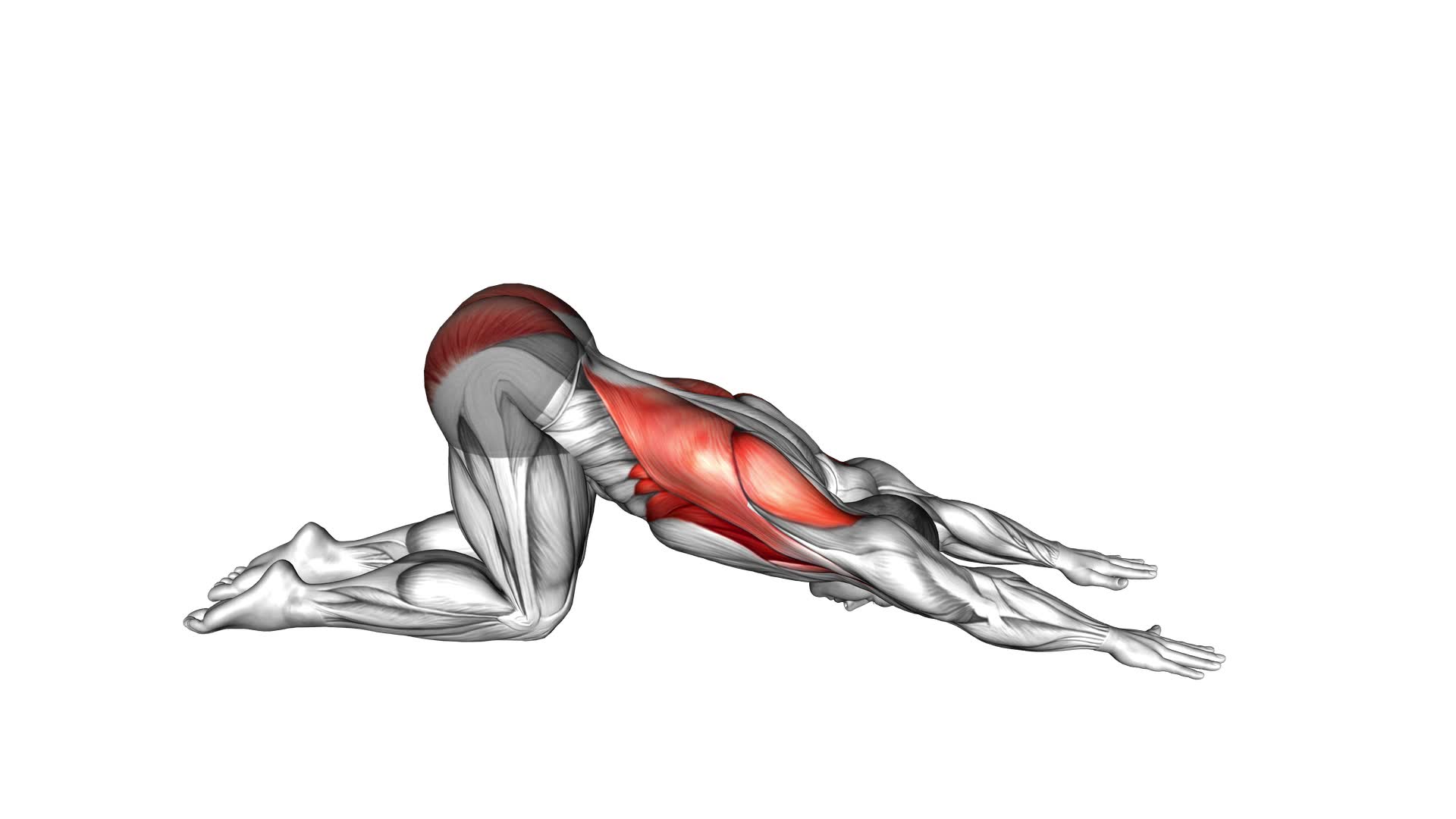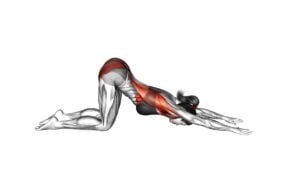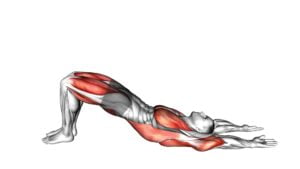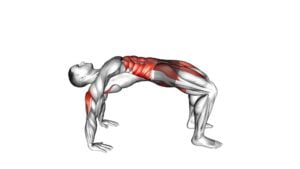Puppy Pose (male) – Video Exercise Guide & Tips

Get ready to stretch and strengthen your body with the Puppy Pose!
Watch This Exercise Video
In this video exercise guide, we'll show you step by step how to perform this pose correctly. Whether you're a beginner or more advanced, we've got modifications for all fitness levels.
Plus, we'll share some tips to ensure you practice safely and effectively.
So grab your mat, hit play, and let's get started on this energizing and rejuvenating yoga pose!
Key Takeaways
- Puppy Pose stretches and strengthens the arms, shoulders, back, and spine.
- It improves posture and relieves tension in the upper body.
- The pose provides a gentle stretch to the hips and thighs, promoting flexibility and mobility in these areas.
- Puppy Pose helps release stress and calms the mind.
Benefits of the Puppy Pose
Discover the numerous benefits of the Puppy Pose for your body and mind. The Puppy Pose is a yoga posture that offers a wide range of health benefits. It's known to stretch and strengthen various muscle groups, including the arms, shoulders, back, and spine. By opening up the chest and elongating the spine, this pose can improve posture and relieve tension in the upper body.
This pose also provides a gentle stretch to the hips and thighs, promoting flexibility and mobility in these areas. It can help alleviate tightness and discomfort caused by prolonged sitting or standing. Additionally, the Puppy Pose is an excellent way to release stress and calm the mind. The forward fold position allows for deep relaxation and can help reduce anxiety and fatigue.
Variations and modifications of the Puppy Pose can be incorporated to suit individual needs and abilities. For those with limited flexibility or wrist issues, using props like blankets or blocks can provide additional support. By adjusting the distance between the knees and hands, one can increase or decrease the intensity of the stretch.
Proper Alignment for the Pose
To achieve proper alignment for the Puppy Pose, ensure that your shoulders are directly over your wrists and your hips are stacked above your knees. This alignment is crucial to maximize the benefits of the pose and prevent any strain or injury.
One common misconception is that the shoulders should be pushed forward in this pose. However, this can put excessive pressure on the wrists and cause discomfort. Instead, focus on keeping your shoulders in line with your wrists, allowing for a neutral and stable upper body position.
Another variation of the pose involves widening your knees slightly to create a wider base of support. This can be helpful for individuals with limited hip mobility or those who find it difficult to keep their hips directly above their knees. By widening the knees, you can find a more comfortable position and still reap the benefits of the pose.
Now that you understand the proper alignment for the Puppy Pose, it's time to explore modifications for different fitness levels. These modifications will allow you to adapt the pose to your individual needs and gradually progress as you become more comfortable and flexible.
Modifications for Different Fitness Levels
Adjusting the height of your hands can provide modifications for different fitness levels in the Puppy Pose. If you're a beginner or have limited flexibility, start by placing your hands at a higher position, such as on a block or a bolster. This will reduce the intensity of the stretch and make it more accessible for you. As you become more comfortable and flexible, you can gradually lower your hands to the ground, eventually reaching the full expression of the pose.
For those with injuries or physical limitations, there are adaptations you can make to still benefit from the Puppy Pose. If you have wrist or shoulder issues, you can place your forearms on the ground instead of your hands, creating a modified version of the pose. This will help alleviate any discomfort or pain in those areas. Additionally, if you have knee problems, you can place a blanket or a bolster under your knees for support.
Advanced practitioners can explore variations of the Puppy Pose to deepen their practice. One option is to extend your arms forward, creating a longer stretch in the shoulders and upper back. Another variation is to walk your hands to one side, stretching one side of the body at a time. These variations can challenge your strength and flexibility, providing new opportunities for growth in your yoga practice. Remember to listen to your body and only go as far as feels comfortable for you.
Tips for a Safe and Effective Practice
To ensure a safe and effective practice, use proper form and engage your core throughout the Puppy Pose. Here are some tips to help you make the most out of your practice:
- Use the right yoga equipment:
It's important to have a good quality yoga mat that provides enough cushioning and grip to support your body during the pose. This will help prevent any discomfort or injuries while practicing.
- Focus on your breathing:
Deep and controlled breathing is crucial in yoga. As you move into the Puppy Pose, inhale deeply through your nose, allowing your chest and belly to expand. As you exhale, engage your core and gently press your chest towards the ground. This will help you relax and deepen the stretch.
- Listen to your body:
Pay attention to any discomfort or pain during the pose. If something doesn't feel right, modify the pose or come out of it altogether. Remember, yoga is about honoring your body and its limitations.
By following these tips and practicing with mindfulness, you can ensure a safe and effective Puppy Pose practice.
Remember to always consult with a qualified yoga instructor or healthcare professional before starting any new exercise routine. Enjoy your practice and reap the benefits of this gentle and restorative pose.
Common Mistakes to Avoid
Avoid these common mistakes when practicing the Puppy Pose. It's crucial to maintain proper form to get the most out of this yoga pose.
One common mistake is collapsing the chest and rounding the shoulders. Instead, focus on keeping the chest open and the shoulders relaxed, pulling them away from the ears.
Another mistake to avoid is sinking the hips too low, which can strain the lower back. Keep the hips in line with the knees and maintain a neutral spine.
It's also important to engage the core muscles to support the lower back and maintain stability.
Another common mistake is placing too much weight on the wrists, which can lead to discomfort or injury. Instead, distribute the weight evenly between the hands and the knees.
Lastly, avoid rushing through the pose. Take your time to find a comfortable position and breathe deeply, allowing your body to relax and release tension.
Frequently Asked Questions
How Many Times a Week Should I Practice the Puppy Pose?
To get the most out of the puppy pose, you should practice it regularly. As for how many times a week, it depends on your fitness level and goals. Generally, aim for at least three times a week to see improvements in flexibility and posture.
The puppy pose benefits include stretching the spine, shoulders, and chest, and it can also help relieve stress and tension. Remember to listen to your body and make any necessary modifications to make the pose work for you.
Can the Puppy Pose Help With Back Pain?
The puppy pose can be beneficial for back pain. By stretching and lengthening the spine, it helps relieve tension and improve flexibility.
To modify the pose, you can use props like blocks or bolsters for support. Start on all fours, then walk your hands forward while keeping your hips above your knees.
Lower your chest towards the floor and rest your forehead on the mat. Stay in this position for a few breaths to experience the benefits.
Is It Necessary to Warm up Before Doing the Puppy Pose?
Before starting the Puppy Pose, it's important to warm up your body. Warming up helps prepare your muscles and joints for the exercise, reducing the risk of injuries. It increases blood flow, flexibility, and range of motion.
Can the Puppy Pose Help Improve Flexibility?
The puppy pose is a great exercise for improving flexibility. By stretching your spine and elongating your back, it helps improve posture and release tension in your shoulders and neck.
The benefits of puppy pose extend beyond flexibility, as it also helps to calm the mind and reduce stress. Incorporating this pose into your regular routine can lead to increased flexibility and overall well-being.
Are There Any Variations of the Puppy Pose for Pregnant Women?
There are indeed variations of the puppy pose specifically designed for pregnant women. These modifications take into consideration the changes in the body during pregnancy and prioritize the safety and comfort of the mother-to-be.
The benefits of the puppy pose for prenatal fitness include stretching the spine, shoulders, and hips, as well as relieving tension in the upper back and neck. It's a gentle yet effective exercise that can be incorporated into a prenatal fitness routine.
Conclusion
In conclusion, the puppy pose is a beneficial exercise for improving flexibility and relieving tension in the back and shoulders.
By practicing proper alignment and making modifications based on your fitness level, you can safely and effectively engage in this pose.
Remember to avoid common mistakes and listen to your body's limits.
With these tips and guidance, you can confidently incorporate the puppy pose into your fitness routine.

Author
Years ago, the spark of my life’s passion ignited in my mind the moment I stepped into the local gym for the first time. The inaugural bead of perspiration, the initial endeavor, the very first surge of endorphins, and a sense of pride that washed over me post-workout marked the beginning of my deep-seated interest in strength sports, fitness, and sports nutrition. This very curiosity blossomed rapidly into a profound fascination, propelling me to earn a Master’s degree in Physical Education from the Academy of Physical Education in Krakow, followed by a Sports Manager diploma from the Jagiellonian University. My journey of growth led me to gain more specialized qualifications, such as being a certified personal trainer with a focus on sports dietetics, a lifeguard, and an instructor for wellness and corrective gymnastics. Theoretical knowledge paired seamlessly with practical experience, reinforcing my belief that the transformation of individuals under my guidance was also a reflection of my personal growth. This belief holds true even today. Each day, I strive to push the boundaries and explore new realms. These realms gently elevate me to greater heights. The unique combination of passion for my field and the continuous quest for growth fuels my drive to break new ground.







